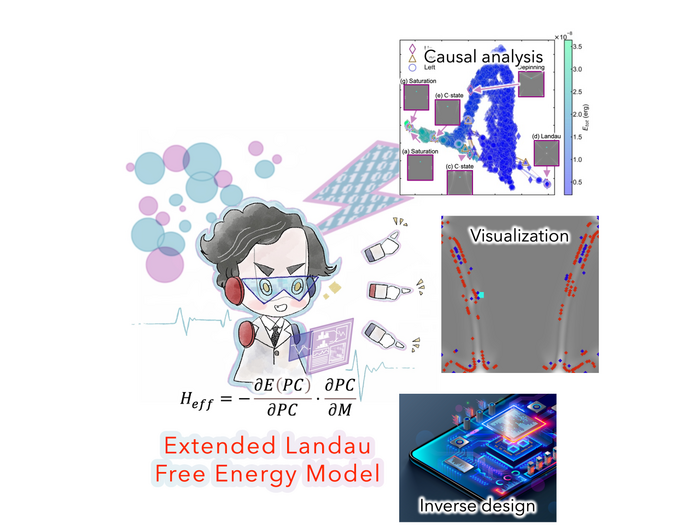Microscopic materials analysis is essential to achieve desirable performance in next-generation nanoelectronic devices, such as low power consumption and high speeds. However, the magnetic materials involved in such devices often exhibit incredibly complex interactions between nanostructures and magnetic domains. This, in turn, makes functional design challenging.

Credit: Kotsugi Laboratory from Tokyo University of Science, Japan.
Microscopic materials analysis is essential to achieve desirable performance in next-generation nanoelectronic devices, such as low power consumption and high speeds. However, the magnetic materials involved in such devices often exhibit incredibly complex interactions between nanostructures and magnetic domains. This, in turn, makes functional design challenging.
Traditionally, researchers have performed a visual analysis of the microscopic image data. However, this often makes the interpretation of such data qualitative and highly subjective. What is lacking is a causal analysis of the mechanisms underlying the complex interactions in nanoscale magnetic materials.
In a recent breakthrough published in Scientific Reports, a team of researchers led by Prof. Masato Kotsugi from Tokyo University of Science, Japan succeeded in automating the interpretation of the microscopic image data. This was achieved using an “extended Landau free energy model” that the team developed using a combination of topology, data science, and free energy. The model could illustrate the physical mechanism as well as the critical location of the magnetic effect, and proposed an optimal structure for a nano device. The model used physics-based features to draw energy landscapes in the information space, which could be applied to understand the complex interactions at the nanoscales in a wide variety of materials.
“Conventional analysis are based on a visual inspection of microscope images, and the relationships with the material function are expressed only qualitatively, which is a major bottleneck for material design. Our extended Landau free energy model enables us to identify the physical origin and location of the complex phenomena within these materials. This approach overcomes the explainability problem faced by deep learning, which, in a way, amounts to reinventing new physical laws,” Prof. Kotsugi explains. This work was supported by KAKENHI, JSPS, and the MEXT-Program for Creation of Innovative Core Technology for Power Electronics Grant.
When designing the model, the team made use of the state-of-art technique in the fields of topology and data science to extend the Landau free energy model. This led to a model that enabled a causal analysis of the magnetization reversal in nanomagnets. The team then carried out an automated identification of the physical origin and visualization of the original magnetic domain images.
Their results indicated that the demagnetization energy near a defect gives rise to a magnetic effect, which is responsible for the “pinning phenomenon.” Further, the team could visualize the spatial concentration of energy barriers, a feat that had not been achieved until now. Finally, the team proposed a topologically inverse design of recording devices and nanostructures with low power consumption.
The model proposed in this study is expected to contribute to a wide range of applications in the development of spintronic devices, quantum information technology, and Web 3.
“Our proposed model opens up new possibilities for optimization of magnetic properties for material engineering. The extended method will finally allow us to clarify ‘why’ and ‘where’ the function of a material is expressed. The analysis of material functions, which used to rely on visual inspection, can now be quantified to make precise functional design possible,” concludes an optimistic Prof. Kotsugi.
***
Reference
DOI: https://doi.org/10.1038/s41598-022-21971-1
About The Tokyo University of Science
Tokyo University of Science (TUS) is a well-known and respected university, and the largest science-specialized private research university in Japan, with four campuses in central Tokyo and its suburbs and Hokkaido. Established in 1881, the university has continually contributed to Japan’s development in science by inculcating a love for science in researchers, technicians, and educators.
With a mission of “Creating science and technology for the harmonious development of nature, human beings, and society”, TUS has undertaken a wide range of research from basic to applied science. TUS has embraced a multidisciplinary approach to research and has undertaken intensive study in some of today’s most vital fields. TUS is a meritocracy where the best in science is recognized and nurtured. It is the only private university in Japan that has produced a Nobel Prize winner and the only private university in Asia to produce Nobel Prize winners within the natural sciences field.
Website: https://www.tus.ac.jp/en/mediarelations/
About Professor Masato Kotsugi from Tokyo University of Science
Professor Masato Kotsugi graduated from Sophia University, Japan, in 1996 and subsequently received his Ph.D. from the Graduate School of Engineering Science at Osaka University, Japan in 2001. He joined the Tokyo University of Science in 2015 as a lecturer and is currently a Professor at the Faculty of Advanced Engineering, Department of Materials Science and Technology. Prof. Kotsugi and his students conduct cutting-edge research on high-performance materials to create a green energy society. He has published over 127 refereed papers and is currently interested in solid-state physics, magnetism, synchrotron radiation, and materials informatics. He can be reached at: [email protected]
Funding information
This study was supported by KAKENHI, JSPS [21H04656]. Part of this study was supported by MEXT-Program for Creation of Innovative Core Technology for Power Electronics Grant Number JPJ009777, and KAKENHI, JSPS [19K22117, 22K14590].
Journal
Scientific Reports
DOI
10.1038/s41598-022-21971-1
Method of Research
Computational simulation/modeling
Subject of Research
Not applicable
Article Title
Causal Analysis and Visualization of Magnetization Reversal using Feature Extended Landau Free Energy
Article Publication Date
29-Nov-2022
COI Statement
The authors declare no competing interests.




